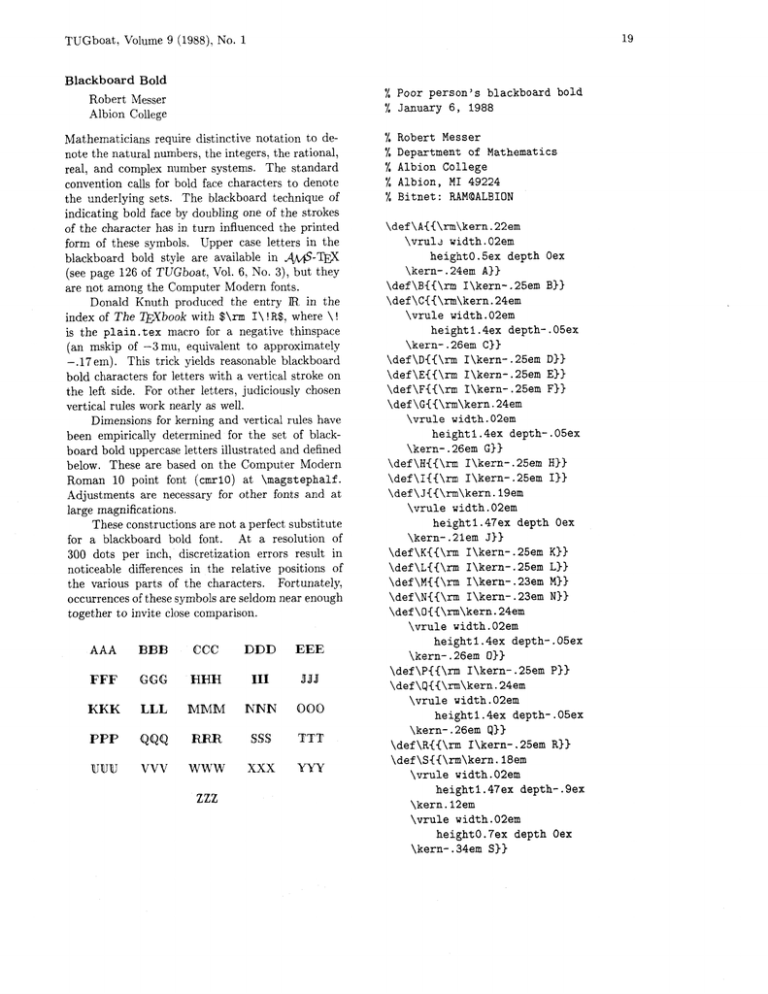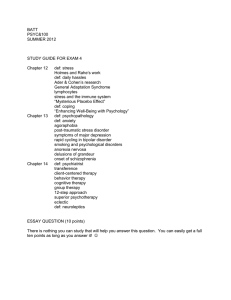UUU VVV ZZZ TTT
advertisement

TUGboat, Volume 9 (1988), No. 1
Blackboard Bold
Robert Messer
Albion College
% Poor person's blackboard bold
% January 6, 1988
Mathematicians require distinctive notation to denote the natural numbers, the integers, the rational,
real, and complex number systems. The standard
convention calls for bold face characters to denote
the underlying sets. The blackboard technique of
indicating bold face by doubling one of the strokes
of the character has in turn influenced the printed
form of these symbols. Upper case letters in the
blackboard bold style are available in AJ&-~$$
(see page 126 of TUGboat, Vol. 6, No. 3 ) , but they
are not among the Computer Modern fonts.
Donald Knuth produced the entry IR in the
index of The W b o o k with $\rm I\!R$,where \ !
is the plain.tex macro for a negative thinspace
(an mskip of -3 mu, equivalent to approximately
-.17em). This trick yields reasonable blackboard
bold characters for letters with a vertical stroke on
the left side. For other letters, judiciously chosen
vertical rules work nearly as well.
Dimensions for kerning and vertical rules have
been empirically determined for the set of blackboard bold uppercase letters illustrated and defined
below. These are based on the Computer Modern
Roman 10 point font (cmrlO) at \magstephalf.
Adjustments are necessary for other fonts and a t
large magnifications.
These constructions are not a perfect substitute
for a blackboard bold font. At a resolution of
300 dots per inch, discretization errors result in
noticeable differences in the relative positions of
the various parts of the characters. Fortunately,
occurrences of these symbols are seldom near enough
together to invite close comparison.
AAA
BBB
CCC
DDD
EEE
FFF
GGG
HHH
I11
585
KKK
LLL
IMMM
NNN
000
PPP
QQQ
RRR
%%%
TTT
UUU
VVV
WWW
XXX
w
ZZZ
%
%
%
%
%
Robert Messer
Department of Mathematics
Albion College
Albion, MI 49224
Bitnet: RAMQALBION
\def \A{{\rm\kern. 22em
\vrul~width.02em
height0.5ex depth Oex
\kern-.24em )A
\def\B{{\rm I\kern-.25em )B
\def\CCC\rm\kern.24em
\vrule width.02em
heightl.4ex depth-.05ex
\kern-.26em C))
\def\D{{\rm
I\kern-.25em )D
\def\E{{\rm
I\kern-.25em E))
\def\F{{\rm
I\kern-.25em )F
\def\G{{\rm\kern.24em
\vrule width.02em
heightl.4ex depth-.05ex
\kern-.26em GI)
I\kern-.25em HI)
\def\H{{\rm
\def\I{{\rm I\kern-.25em )I
\def\J{{\rm\kern.lSem
\vrule width.02em
heightl.47ex depth Oex
\kern-.2lem )
J
\def\K({\rm
I\kern-.25em K)
\def\L{{\rm I\kern-.25em )L
\def\M{{\rm
I\kern-.23em )M
\def\N{{\rm
I\kern-.23em )
N
\def\O{(\rm\kern.24em
\vrule width.02em
heighti.4ex depth-.05ex
\kern-.26em 0))
\def\P{{\rm
I\kern-.25em PI3
\def\Q{C\rm\kern.24em
\vrule width.02em
heightl.4ex depth-.05ex
\kern-.26em Q))
\def\R{{\rm
I\kern-.25em R)>
\def\SCC\rm\kern.l8em
\vrule width.02em
heightl.47ex depth-.9ex
\kern.l2em
\vrule width.02em
height0.7ex depth Oex
\kern-.34em S))
TUGboat, Volume 9 (1988), No. 1
\def \TCC\rm\kera.45em
\vrule width.02em
heightl.47ex depth Oex
\kern-.47em TI3
ef \UCC\m\kern. 30em
\vrule width.02em
height I. 47ex depth-.Osex
\kern-.32em U))
ef \VCC\m\kera. 27em
\omle width.O2em
heighc1.47ex depth-.
\kern-.29em V))
\vrule uidth.02em
heightl.47ex depth--9ex
Silvio Levy
Princeton University
In this document I hope to show that typesetting
wing the gr family of fonts can be as
tting English text, and leads to equally
good results. This is meant to be a tutorial, not an
exhaustive discussion; some
d c d remarb that
should be useful after the reader h a acquired some
familiarity with the fonts are printed in fine print.
ln order to typeset Greek text, you need to go
into "Greek mode." This is achieved by typing
in yow document; Greek
t until you type a matching
k. Whib in Greek mode, the letters 'a'
to '2' and 'AA'to 55' come out as Greek letters,
according to the following code:
a ~ y 8 ~ ~ ~ 6 e x h ~ v 5 ~ x p a ~ u ' p x ~ w
abgdeahjiklmnxoprstufqyw
\ke%n.b2em
\vrule width.02em
height0.4ex depth Oex
There is no digamma yet. The same chaacter
ks'will print as 'o'or 'q', depending on its position
in a word.
The system does this by accessing a ligature of 's' with
any other h t t e i that follows it. If, for some reason, you want
to print ten initiizllmedial sigma by itself (as in the table
above), or at the end of a word, you should type 'c'.
? b y to typeset some simple text.now, Create a
file containing the following Iines:
kanacros % where \
This is Greek text.
nsions will require
gibberish:
ims near the top of yom
e used in place of both
Editor's note: Tha&s to Doug Henderson for
FONTing the typesetter fonts from Sihio
soufee files. Dou mr= also responsible for the typesetter renditbnts of the APL fonts
in TUGboat 8#3.

